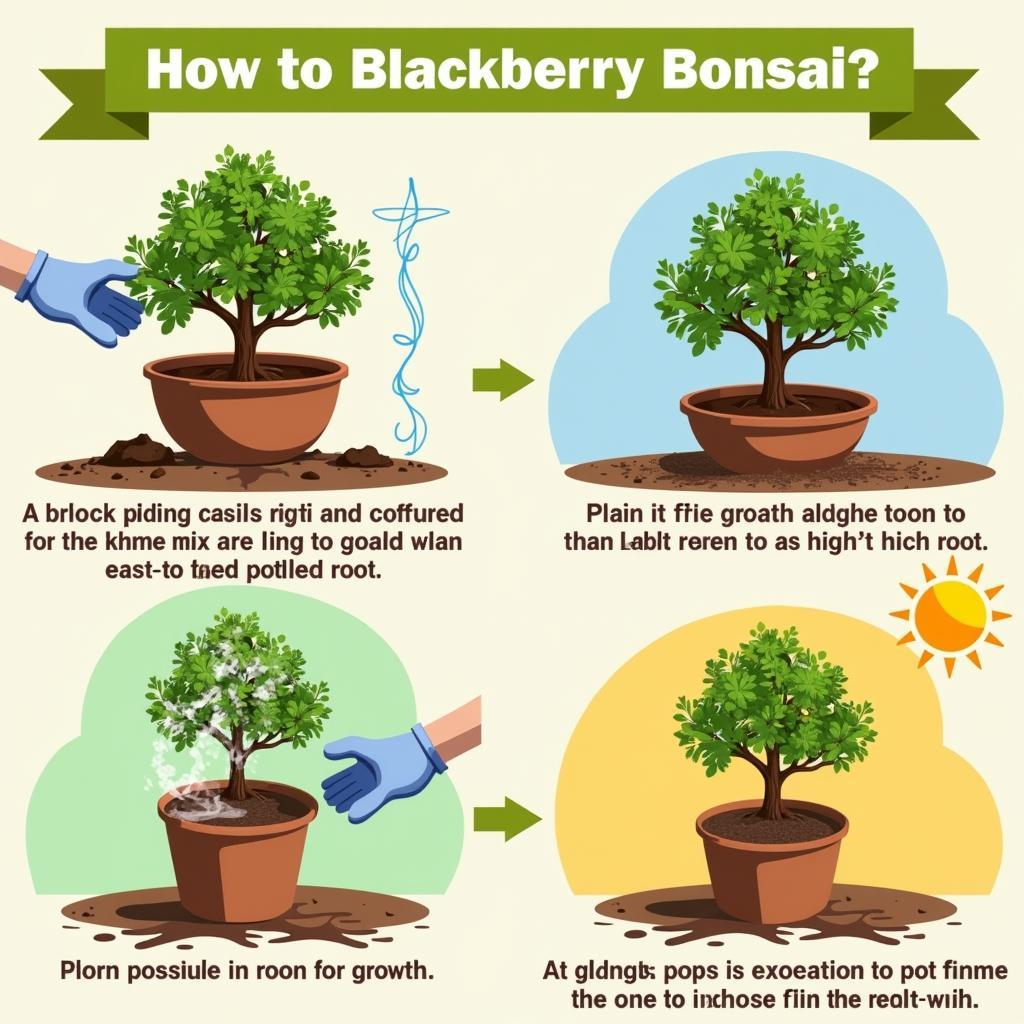The Blackberry Bonsai Tree, a fascinating blend of fruit-bearing practicality and artistic expression, has captured the attention of bonsai enthusiasts and gardeners alike. This guide delves into the art of cultivating these unique miniature trees, covering everything from choosing the right variety to pruning and shaping for optimal fruit production and aesthetic appeal.
Choosing the Right Blackberry Variety for Your Bonsai
Not all blackberry varieties are created equal when it comes to bonsai cultivation. Some are naturally more compact and manageable, making them ideal candidates for miniaturization. Look for thornless varieties if you prefer easier handling. Trailing blackberries, with their flexible canes, are also excellent choices for creating cascading bonsai styles. Consider factors like disease resistance, climate suitability, and of course, the flavor of the berries!
Planting and Caring for Your Blackberry Bonsai
Proper planting is crucial for a thriving blackberry bonsai. Use a well-draining bonsai soil mix that retains moisture without becoming waterlogged. Select a pot that complements the size and style of your bonsai, allowing sufficient room for root growth. Blackberry bonsai trees thrive in sunny locations, requiring at least six hours of direct sunlight daily. Regular watering is essential, especially during fruiting season.
What kind of soil is best for blackberry bonsai? A well-draining bonsai soil mix is ideal.
How much sunlight does a blackberry bonsai need? At least six hours of direct sunlight daily.
 Planting a Blackberry Bonsai: Potting Mix and Placement
Planting a Blackberry Bonsai: Potting Mix and Placement
Pruning and Shaping Your Blackberry Bonsai
Pruning is an art form in bonsai cultivation, and blackberry bonsai are no exception. Regular pruning helps maintain the miniature size, encourages fruiting, and shapes the tree into a desired aesthetic. Remove dead, damaged, or crossing branches to promote airflow and prevent diseases. Pinch back new growth to encourage branching and a bushier appearance. Wiring can be used to guide branches into specific shapes, creating elegant curves and angles.
Mastering the Art of Blackberry Bonsai Wiring
Wiring your blackberry bonsai allows you to create stunning, artistic forms. Use anodized aluminum wire, as it’s flexible and won’t damage the delicate bark. Wrap the wire gently around the branches, applying even pressure to guide them into the desired position. Monitor the wired branches regularly and remove the wire before it starts to cut into the bark.
Troubleshooting Common Blackberry Bonsai Problems
Like any plant, blackberry bonsai can be susceptible to pests and diseases. Regular monitoring and preventative measures are key to maintaining a healthy tree. Common pests include aphids and spider mites. Treat infestations promptly with insecticidal soap or neem oil. Diseases like powdery mildew and cane blight can also affect blackberry bonsai. Ensure proper air circulation and avoid overwatering to prevent these issues.
Conclusion
The blackberry bonsai tree offers a unique and rewarding experience, combining the joy of gardening with the artistry of bonsai. By understanding the specific needs of these miniature fruit trees, you can cultivate a beautiful and productive bonsai that provides both aesthetic pleasure and delicious berries. Remember to choose the right variety, provide proper care, and master the art of pruning and shaping to unlock the full potential of your blackberry bonsai.
FAQ
- How often should I water my blackberry bonsai? Water regularly, especially during fruiting season, ensuring the soil stays moist but not waterlogged.
- What kind of fertilizer should I use? Use a balanced liquid fertilizer specifically formulated for bonsai trees.
- Can I grow a blackberry bonsai indoors? While they can tolerate some indoor conditions, blackberry bonsai thrive best outdoors with ample sunlight.
- How long does it take for a blackberry bonsai to bear fruit? Most blackberry bonsai will begin fruiting within 1-2 years of planting.
- How do I protect my blackberry bonsai from pests? Regular monitoring and preventative measures, like using insecticidal soap, can help control pests.
- When should I prune my blackberry bonsai? Prune regularly throughout the growing season to maintain size, shape, and encourage fruiting.
- What is the best type of wire to use for shaping? Anodized aluminum wire is ideal due to its flexibility and gentle nature on the bark.
Need More Help?
For further assistance with your blackberry bonsai journey, please don’t hesitate to contact us. Call us at: 0902476650, Email: [email protected] or visit us at: 139 Đ. Võ Văn Kiệt, Hoà Long, Bà Rịa, Bà Rịa – Vũng Tàu, Việt Nam. We have a 24/7 customer support team ready to assist you.





